HPLC Systems and Components Introduced at Pittcon 2010: A Brief Review
LCGC North America
Michael Swartz presents his first annual review of HPLC systems and accessories at Pittcon 2010.
Many high performance liquid chromatography (HPLC) vendors have for years coordinated their new product development cycle around the Pittcon schedule, planning to introduce new technology at the conference for the first time. Although the proliferation of additional, specialized conferences has altered this approach somewhat in recent years (for example, many new mass spectrometry [MS] new product introductions are now made at ASMS), Pittcon still remains a real must-go-to meeting to see the latest and greatest in HPLC and related technology. Because Pittcon attracts nearly 20,000 attendees from industry, academia, and government from over 90 countries worldwide, the conference provides a great opportunity for vendors to expose new HPLC products to both new and existing customers. For the attendees, the conference provides a venue to evaluate the latest instrumentation, compare vendors, participate in product demonstrations, and to speak with technical staff to resolve problems or investigate potential applications.

Michael Swartz
At this year's Pittcon, held February 28–March 5 in Orlando, Florida, several vendors introduced new systems and components, as well as product line extensions. In this installment of "Innovations in HPLC," I'll review some of the new HPLC instrument technology shown at the conference; new column and sample preparation technology will be reviewed by Ron Majors in his "Column Watch" column. The information in this review is partially based upon manufacturers' responses to a preconference questionnaire mailed in late 2009. I have used the information received in the questionnaires that were returned, as well as information from personal visits to as many vendors as I could during the conference to try to make this review as comprehensive as possible. But keep in mind that due to the fact that some manufacturers did not respond to the questionnaire, or do not release preshow information — and because of the the sheer size of the conference — this report cannot be considered an exhaustive listing of all new products that were introduced in Orlando. I'm bound to have missed a few items or details, so I'll apologize in advance for any omissions. Table I lists the product introductions reviewed in this column.
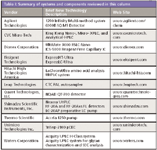
Table I: Summary of systems and components reviewed in this column
UHPLC Systems
HPLC is a proven technique that has been used in laboratories worldwide over the past 30-plus years. One of the primary drivers for the growth of this technique has been the evolution of packing materials used to effect the separation. As the column particle size decreases to less than 2.5 μm, not only is there a significant gain in efficiency, but the efficiency does not diminish at increased flow rates or linear velocities. By using smaller particles, speed and peak capacity (number of peaks resolved per unit time) can be extended to new limits. This technique is referred to as ultrahigh-pressure liquid chromatography (UHPLC) (1,2). UHPLC takes full advantage of chromatographic principles to run separations using higher flow rates and columns packed with smaller particles for increased speed and superior resolution and sensitivity. UHPLC was first introduced at Pittcon 2004 in Chicago, with the introduction of the Waters Acquity UPLC system (Waters Corp., Milford, Massachusetts) and reports claim that UHPLC systems will exceed 50% of the market by the year 2013. Several manufacturers have introduced UHPLC systems of their own in the years since 2004. This year in Orlando was no exception, where new systems, system variations, and components were introduced.
Building upon the success of the Prominence LC-20A Series, Shimadzu Scientific Instruments (Columbia, Maryland) introduced the Nexera UHPLC system, billed as an all-around HPLC system that enables various types of analysis including conventional HPLC, ultrafast LC, and UHPLC at pressures up to 19,000 psi, at flow rates ranging from 100 nL/min to 5 mL/min. The binary pump uses microsapphire plunger-driven pistons (10-μL pump head volume) in a parallel design, with mixing accomplished in an innovative low delay volume, ultrahigh-speed microreactor design, called the MiRC, as shown in the schematic in Figure 1. The XYZ-style injector features a through needle design with a fixed-loop option for fast analyses, with an injection cycle as short as 10 s, and injection volumes of 0.1–50 μL. To reduce the delay volume in the injector, an omega-shaped rotor design is used that reduces tubing lengths and the number of connections required. Up to three rinse liquids can be programmed to rinse the inside and the outside of the needle, as well as the injection port to minimize carryover. In pretreatment mode, the autosampler is also capable of performing precolumn derivatizations, additions of internal standards, and dilutions. The Nexera Rack Changer has temperature control (4–40 °C) and a capacity of up to 12 sample plates for a total of up to 4608 samples. The column oven can go up to 150 °C (nice for "green" 100% water mobile phase use), and has a two-column capacity. It incorporates a solvent preheater (referred to as the Intelligent Heat Balancer-IHB) that adjusts and balances the mobile phase temperature according to the flow rate and the column set temperature to minimize the affect of frictional heating at the head of the column. The total system delay volume is less than 42 μL with the ultra-low volume (20 μL) mixer, optional loop injection kit with 5-μL loop and microvolume preheater. Absorbance, fluorescence, and MS detector applications were shown.
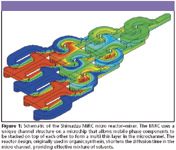
Figure 1
Following in the footsteps of the innovative Acquity UPLC System, Waters (Milford, Massachusetts) introduced its next generation UHPLC instrument called the ACQUITY UPLC H-Class system. The H-Class system combines the flexibility of quaternary solvent blending and a flow-through-needle injector to bring the features of the original UPLC instrument to a wider HPLC audience. The ACQUITY UPLC H-Class was designed to allow organizations to standardize their approach to LC with a common technology platform that makes the future transition from HPLC to UPLC sub-2-μm technology-based methods straightforward and practical. The H-Class quaternary low-pressure mixing system uses a separate gradient proportioning valve for each solvent and a five-chamber integrated vacuum degassing system — four for the solvent lines, one dedicated to the injector needle wash for added precision. Flow can be programmed from 0.010 to 2.000 mL/min, in 0.001-mL/min increments, with a maximum operating pressure of 15,000 psi up to 1 mL/min, or 9000 psi up to 2 mL/min, with a total system volume of under 400 μL. For method development, the H-Class Quaternary Solvent Manager (QSM) can be used to prepare mobile phases on the fly, or "Autoblend," a technique that has been used in HPLC for many years. Premixing solvents during method development can be wasteful, as mobile phase combinations are tried that ultimately might not be used in the final method. Autoblend avoids having to discard unused mobile phase as individual neat solvents are used, making it easier to maintain pH and ionic strength and resulting in more robust methods. In addition, optional, integrated software-controlled solvent select valves increases to nine the number of solvents that can be evaluated during method development, and with the addition of column switching valves, the number of discreet methods that can be run on one system.
In the original ACQUITY UPLC System, the sample manager uses a loop injector, and a choice between different injection procedures (full loop, partial loop, with and without overfill) can be made with the method objectives (accuracy, precision) in mind. The more traditional HPLC autosampler-type flow-through needle design in the H-Class sample manager can be used in both the HPLC and UHPLC mode, which makes the transition between techniques much simpler. Because the entire needle is flushed with mobile phase from the method, a complete, quantitative transfer of the sample is accomplished, which results in better accuracy and precision and decreased carryover. In addition, the way the flow path is managed keeps the sample in the tip of the needle. When the flow is reversed to the column during the actual injection, dispersion that can lead to decreased resolution is minimized. The design also minimizes dispersion when an extension tube is added when performing larger volume injections. H-Class's patent-pending SmartStart Technology automatically manages gradient start time and preinjection steps in parallel to reduce inject-to-inject cycle times to less than 30 s. The H-Class uses what the company calls Quantum Synchronization to synchronize the injection with the pump stroke to improve precision (retention time reproducibility). Injection volumes of 0.1–10.0 μL are standard, and an optional extension loop can extend the volume to 250.0 μL. Samples can be maintained in a temperature-controlled environment at 4–40 °C. An active integrated programmable needle wash is used, and the sample manager can perform autodilution and sample transfer routines.
Several new column oven options complete the H-Class system package. The standard CH-A column heater can accommodate a single column (up to 150 mm × 4.6 mm) at 20–90 °C (dependent upon ambient temperature, requiring a setting 5 °C above ambient for control). A second option is a CM-A column manager that includes two selection valves, one inlet, and one outlet. The CM-A can accommodate two columns (up to 150 mm × 4.6 mm) at 4–90 °C, and it has both heating and cooling capabilities to operate below ambient room temperature. Column capacity can be increased by adding up to two additional CHC-A modules, for a total of six columns with automatic random access switching, individual temperature control (each column can be at a different temperature), and waste and bypass positions for rapid solvent changeovers in method development or multimethod use. All three of the column devices (CH-A, CM-A, and CHC-A) include an active preheater (APH) cartridge (one independently controlled cartridge for each column position) that can be turned on or off — the latter in case you need to run a legacy passive heating method — and eCord column information management that tracks and archives column usage history. A final option called the CH30-A accommodates two columns as large as 300 mm × 4.6 mm at 20–90 °C (dependent upon ambient temperature) and includes the inlet and outlet selection valves. It is intended that any combination of these column devices can work together in a single system. The H-class can be used with the existing line of photodiode-array (PDA), tunable UV, evaporative light scattering, fluorescence, single and tandem quadrupole MS detectors, as well as the sample organizer that depending upon the type of plates used, can extend the sample capacity from 768 (standard) to over 8000.
Thermo Fisher Scientific (Waltham, Massachusetts) introduced the model 1250, a new pump version to enhance its Accela system, extending the pressure range and adding additional capabilities. The Accela 1250 pump is a quaternary pump that uses Thermo's Force Feedback Control (FFC) technology that continually autocalibrates valve timing and pumping efficiency based upon the actual measured compressibility of solvents. The result is extremely low pulsation (lower than 0.5 bar amp.) without the need of a pulse dampener. FFC technology is also utilized in the Thermo 600 series pumps (8700 psi). The model 1250 extends the operating pressure of the Accela system to over 18,000 psi, at flow rates of 1–2000 μL/min with a low pressure mixing system delay volume under 70 μL. The 1250 is incorporated into the Accela system first introduced in 2005 and uses the existing Accela autosampler and PDA detector.
Eksigent (Dublin, California) came out with the ExpressHT-Ultra and ExpressLC-Ultra systems designed for micro- and high-throughput operation (respectively) at up to 10,000 psi to take advantage of sub-2-μm column technology. Using a binary pneumatically driven pump the number of moving parts is significantly reduced, and with Microfluidic Flow Control (MFC) technology, the flow rate is continuously monitored and a feedback loop makes fast, real-time adjustments to maintain flow and gradient reproducibility. Both systems include an industry-standard CTC autosampler (Leap Technologies, Carrboro, North Carolina) capable of injection volumes as low as 50 nL. As configured with the CTC autosampler, the Eksigent systems have one of the smallest footprints of any systems on the market. The ExpressHT-Ultra is designed for 1-mm i.d. HPLC column operation and bioanalytical applications with inject-to-inject cycle times as low as 60 s. Flow rates of 50–200 μL/min are standard, with a gradient delay volume of less than 10 μL. The ExpressLC-Ultra is designed for 0.5-mm i.d. HPLC column operation for improving sensitivity. The system uses a CCD-based UV detector with a microfabricated fiber-optic flow cell with either 5- or 10-mm optical pathlengths or volumes as small as 90 nL. Flow rates of 1–50 μL/min are standard, with a gradient delay volume of 1.2 μL.
The Shimadzu Nexera, Waters ACQUITY H-Class, the Thermo Accela 1250, and the Eksigent ExpressHT-Ultra and ExpressLC-Ultra systems join the Waters ACQUITY UPLC, Agilent 1290 Infinity (Santa Clara, California), Dionex Ultimate 3000 (Sunnyvale, California), PerkinElmer Flexar (Waltham, Massachusetts), Hitachi LaChromUltra U-HPLC (Pleasanton, California), and the Jasco X-LC (Easton, Maryland) in sub-2-μm column capability, proof that UHPLC is here to stay.
Specialty HPLC–UHPLC Systems
For the purposes of this review, I'll define specialty systems as systems configured for a particular test, application, or use. For Pittcon 2010, Agilent introduced the 1290 Infinity Multi-method System, a multicolumn and multi-solvent selection system. In the UHPLC version of the Agilent Multi-method and Method Development Solution, pressures up to 16,800 psi at 2 mL/min and 11,200 psi at 5 mL/min in binary operation, or 5600 psi at 5 mL/min and 2800 psi at 10 mL/min in quaternary operation can be used. The system is based upon a 1290 Infinity System (Pittcon 2009 introduction) using a cluster of up to three thermostatted column compartments with integrated eight-column ultrahigh-pressure selection valves mounted on a slide-out rail for easy installation and maintenance. The system also can accommodate up to two 12-position solvent-selection valves, and both the column and solvent-selection valves can be chosen through software radio buttons showing the column's name or by a dropdown menu showing the solvent names. The quick-change valves have radio-frequency identification (RFID) tags on the valve heads providing documentation of the valve type, serial number, number of switches, and the pressure setting.
The design facilitates open access, software-selectable unattended and automated use of multiple separation conditions; at capacity, the combination of eight columns (if a waste or bypass is used the number of columns is reduced) and 26 solvents results in over 1000 unique separation conditions for binary separations. Column dimensions up to 300 mm × 4.6 mm can be accommodated, with six separate heating zones (up to 100 °C). The system can be run in conjunction with method development software packages such as ChromSword (Iris Technologies, Olath, Kansas) automated method optimization software, the Agilent ChemStation Method Scouting Wizard software, and Advanced Chemistry Development (ACD/Labs, Toronto, Ontario, Canada) ChromGenius software. Existing model 1290 Infinity autosamplers can be used, or a new high-throughput injector. A range of detectors is also available that includes multiple, variable, and diode-array UV, fluorescence, refractive index, evaporative light scattering, and the new 6100 Series Quadrupole MS system.
When the model "T" first came out, Henry Ford used to say: "You can have any color you want-as long as it's black." Similarly, in 2004, when UHPLC was first introduced, you could have any column you wanted, as long as it was C18. These days, there are many more column flavors available, many of which are scalable between HPLC and UHPLC particle sizes. Many vendors now have columns available over a wide variety of chemistries and particle sizes, and have configured method development, validation, and transfer kits that contain an assortment of columns, chemistries, and column–method calculators all designed to take the guess work out of method development, method migration (HPLC to UHPLC), and method transfer. Capitalizing on its column chemistry, Waters introduced three application-specific systems based upon the ACQUITY line. For the characterization of 2-AB–labeled glycans from glycoproteins, Waters has combined its UHPLC glycan columns with the ACQUITY system equipped with fluorescence detection. An example separation using this system is shown in Figure 2. Current FDA regulations recommend that firms developing and manufacturing therapeutic proteins are able to accurately characterize the glycans attached to those proteins to ensure the efficacy and safety of a biopharmaceutical product. In 35 min or less, the system can profile an array of oligosaccharides including high mannose and complex, hybrid, and sialylated glycans. For separating and quantifying monoclonal antibodies (mAb) and their aggregates in less than 4 min, Waters has combined its BEH200 1.7-μm size-exclusion chromatography columns with the ACQUITY system, making it faster and easier for manufacturers to achieve high-quality data that meets FDA recommendations for quantifying protein aggregates suspected of being capable of producing an immunogenic response in some patients. A complementary line of high-resolution ion-exchange columns also were introduced for protein separations. Waters also introduced an alternative to off-line solid-phase extraction (SPE) by combining the ACQUITY system with on-line, automated SPE, providing analyte extraction, concentration, separation, and detection in one automated solution.
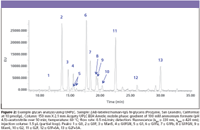
Figure 2
Another application-specific system was introduced by Hitachi: the LaChromUltra Amino Acid Analysis UHPLC system. The system is based upon Hitachi's UHPLC system, and is for the rapid high-resolution analysis of amino acids via precolumn derivatization. It is capable of analyzing amino acids in a broad range of sample types including protein hydrolysates, foodstuffs, and cell culture media.
Shimadzu Scientific Instruments was also showing their new, next-generation LC-20AP Preparative LC pump, which can be used for analytical, semipreparative, and preparative LC applications (without changing pump heads) at flow rates of 0.01–150 mL/min at high pressure (6000 psi up to 100 mL/min and 4350 psi up to 150 mL/min). These flow rates and pressures make it possible to use 250 mm × 50 mm, 5-μm particle size columns to achieve high-resolution and high-efficiency purifications and improve productivity. Using higher resolution microstepping motor control, the pump can be used at analytical flows (for example, 1 mL/min), so that a user can develop a method at analytical scale and then immediately convert it for preparative scale on the same system, improving productivity.
Capillary–Nano HPLC Systems
Several new nano systems and a capillary system were introduced in Orlando. Dionex introduced the ICS-5000 Reagent-Free IC (RFIC) system, a capillary ion chromatography (IC) system with the ability to analyze samples at capillary, microbore, or standard analytical flow rates (or any combination of two in a dual system, termed 2D IC). In capillary mode, the ICS-5000 system reduces eluent consumption over 100-fold compared to standard analytical scale operation, which translates to only about 2 L of solvent consumption over several months. Another benefit of capillary IC is that parts-per-trillion level sensitivity can be obtained, again 100-fold better than standard analytical scale detection limits. The heart of the system is the IC Cube, which accommodates cartridge-based consumables like columns and suppressors that can be added or changed easily. The system can be configured with two IC Cubes to facilitate running two applications at the same time in 2D-IC mode. The 2D IC mode allows an analyst to perform both anion and cation analysis with one injection, perform two different anion applications, or eliminate dilutions from unknown samples by running the same application with large loop–small loop injections. Using the capillary mode, analysis times are reduced to less than 5 min for the analysis of seven anions or five cations. as illustrated in Figure 3. The ICS-5000 single pump option can be configured with either capillary or analytical pump heads to support capillary, microbore, standard bore, or semipreparative applications. The pump is upgradeable from a single to a dual pump yielding either a dual capillary, dual analytical, or hybrid (capillary and analytical) pump, which also supports the option of gradient (proportioning valve) operation. In capillary mode, the ICS 5000 has a 6000-psi maximum operating pressure and is capable of flows up to 3 mL/min in 0.0001-mL/min increments. In analytical mode, it has a 5000-psi maximum operating pressure and is capable of producing a 10.000-mL/min flow, adjustable in 0.001-mL/min increments. The pump heads, mixing chamber, and flow path are all composed of inert PEEK material, and the system has an integrated piston seal wash and built-in vacuum degasser. Dual-zone thermal control (10–70 °C for the detectors, depending upon the compartment, and 5–85 °C for the column) provides two independent temperatures for both the column and the detectors; a thermostatted autorange conductivity detector and an electrochemical detector provide increased flexibility and utility.
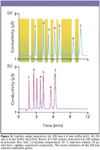
Figure 3
Nano HPLC is a technique that generally involves the application of columns with an internal diameter of 75 μm and flow rates of approximately 300 nL/min. They are ideal for sample-limited applications requiring high sensitivity, such as in proteomics. Dionex also unveiled a system offering in the nano category, called the UltiMate 3000 RSLC Nano system. The RSLC Nano system is available in dual configurations that facilitate preconcentration and sample clean-up steps, and make multidimensional and parallel separations possible. Continuous direct mobile phase flow (no splitting) is delivered by four pistons (two per solvent channel) so that unlike a syringe-driven pump, a refill cycle is not required — during flow delivery of one piston, the other is refilled, and after the refill cycle, the refilled piston is pressurized and takes over the flow delivery. Flow rates ranging from 20 nL/min to 50 μL/min are possible at a maximum pressure of 11,200 psi. All critical flow paths are maintained under temperature control, and injections down to 20 nL are possible. The RSLC Nano system also is capable of automated off-line 2D-LC using combined autosampling and microfraction collection.
CVC Microtech (Fontana, California) also premiered a new system, called the Nano-XPLC system. The Nano-XPLC system is configurable in many different ways; single, dual, ternary or quaternary pumping, and in what the company refers to as "Dual Core" binary mode. In dual core binary mode, one pump is performing a separation, while the second is equilibrated, increasing throughput. The Nano-XPLC can also be configured as a micro or analytical HPLC. Flows and pressures range from 10 nL/min to 20 μL/min at 20,000 psi on the Nano-XPLC, 0.1 μL/min to 2.2 mL/min at 20,000 psi on the Micro-HPLC, and 1 μL/min to 10 mL/min at 6000 psi on the Analytical HPLC. All systems are capable of being configured as single up to quaternary pumps or the 2-D dual-core mode. Systems include a variable-wavelength UV detector, a temperature-controlled (4–40 °C) autosampler accommodating up to five microtiter plates, and an option that includes a combination autosampler–fraction collector that can also function as a matrix-assisted laser desorption ionization (MALDI) spotter. A wide range of column chemistries and applications was shown.
New HPLC Detectors
Detectors for condensation nucleation light scattering detection (CNLSD) are a form of light scattering aerosol detectors that are used in the same type of applications suited for evaporative light scattering detection (ELSD) (3). In CNLSD, following evaporation of the mobile phase, a saturated stream of solvent is added to the particles in the carrier gas. The particles form condensation nuclei and the solvent condenses onto the particles, increasing their size to the point where they are detected more easily in the light path. Due to the increase particle size, CNLSD can be 10–100-fold more sensitive than ELSD, with a wider linear range. At Pittcon 2010, Quant Technologies (Blaine, Minnesota) introduced the NQAD QT-700, a third detector in their line of CNLSD systems for HPLC, UHPLC, and SFC (Quant Technologies sold the original two detectors in their line through Grace, but now sell all detectors in their line direct). Aerosol-based detectors are very useful for applications that involve compounds that do not have a UV chromophore or fluorophore; however, they are destructive detectors, which makes fraction collections and solvent recycling cumbersome. The NQAD QT-700 remedies this by splitting the flow internally to accommodate built in fraction collection and solvent recycling options. Fraction collection allows the chromatographer to isolate individual sample components even if they do not contain a chromophore or fluorophore without cumbersome derivatization steps. Like the Quant QT-600, the 700 is also meant for UHPLC applications; the 500 for HPLC.
Shimadzu Scientific Instruments introduced two new fluorescence detectors, the RF-20A and RF-20Axs. Utilizing a newly designed optical system, and a xenon lamp with extended lamp lifetimes, Shimadzu claims these detectors have the highest sensitivity levels of any HPLC fluorescent detector. Response times as fast as 10 ms allow use in ultrafast LC applications without a loss of separation, and wavelength switching via a time program allows simultaneous testing of multiple components at optimal wavelengths for highly sensitive multicomponent analyses. Because fluorescence intensity drops as temperature increases (a 1 °C change can result in a 5% response difference for some compounds), the RF-20Axs features a temperature-controlled cell with a cooling function to compensate as the environmental temperature fluctuates, ensuring reproducibility without decreasing sensitivity. Applications highlighting amino acid, reducing sugar, and carbamate pesticide analysis were shown.
Also in the detector category, Agilent introduced the 6100B Series single-quadrupole LC–MS system. The B Series uses Agilent's Jet Stream Thermal Gradient Focusing Technology to provide a wide ionization range and added sensitivity. The 6100B is optimized for high-throughput injections and complements the Agilent 1290 Infinity Multi-method system, particularly when using peak tracking software in method development mode.
"Light-pipe" or "light-guided" flow cells have been used for some time, particularly in the newer UHPLC systems to minimize dispersion (4). Agilent introduced new detector cell technology for their diode-array detector that, like light-pipe or light-guided flow cells, utilizes the principle of total internal reflectance along a noncoated fused-silica capillary to increase sensitivity and minimize dispersion. Called Max-Light flow cells, two versions are available in a very convenient "plug and play" cartridge format.
Conclusion
I saw a lot of additional noteworthy items at Pittcon, but time, space, and the scope of this column really prevent me from covering them all in any amount of detail. I was particularly intrigued by the number of major HPLC vendors (for example, Agilent and Waters) exhibiting supercritical fluid technology, which might be a part of the green chemistry movement in some respects, although using SFC for the separation of chiral compounds is also a great fit. I also spent some time looking at the Unimicro Technologies (Pleasanton, California) pressurized electrochromatography system, the TriSep-2100 pCEC. While I don't believe the TriSep pCEC system was new for this Pittcon, I hadn't had a chance to look at it before, and the combination of small-particle pressure-driven flow and electrophoresis provides some rather unique high-efficiency separations.
A number of vendors (Agilent, Thermo Fisher Scientific, Waters, and others) also exhibited systems based upon the CTC PAL Autosampler. Some used valves to create customized solutions or spatial arrangements to produce a small footprint.
Many vendors were also showing chemometric HPLC software for applications such as database tracking of methods (Dionex), method development and robustness evaluation according to quality-by-design (QbD) principles (Waters), or peak tracking method development and experimental design (Agilent, ACD/Labs [Toronto, Canada]).
And finally, while not an instrument or component, but certainly related, another notable HPLC introduction was made in the Wiley (Hoboken, New Jersey) booth. The third edition of Introduction to Modern Liquid Chromatography is now available, a book that should be on every chromatographer's bookshelf (5).
In 2011, Pittcon will return to Atlanta March 13–18. Hope to see you there!
Michael Swartz "Innovations in HPLC" Editor Michael E. Swartz is Research Director at Synomics Pharmaceutical Services, Wareham, Massachusetts, and a member of LCGC's editorial advisory board. Direct correspondence about this column to "Innovations in HPLC," at lcgcedit@lcgcmag.com.
References
(1) The Quest for Ultra Performance in Liquid Chromatography — Origins of UPLC Technology, Waters Corporation. See: http://www.waters.com/waters/partDetail.htm?cid=511539&id=38628&ev=10120661&locale=en_US
(2) Beginners Guide to UPLC — Ultra-Performance Liquid Chromatography. Waters Corporation. See: http://www.waters.com/waters/partDetail.htm?cid=511539&id=38629&ev=10120684&locale=en_US
(3) M. Swartz, J. Liq. Chromatogr., in press, July 2010.
(4) M. Swartz, LCGC 27(12), 1052–1057, (2009).
(5) L.R. Snyder, J.J. Kirkland, and J. Dolan, Introduction to Modern Liquid Chromatography, 3rd Edition (John Wiley and Sons, New York, 2009).
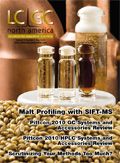
New Method Explored for the Detection of CECs in Crops Irrigated with Contaminated Water
April 30th 2025This new study presents a validated QuEChERS–LC-MS/MS method for detecting eight persistent, mobile, and toxic substances in escarole, tomatoes, and tomato leaves irrigated with contaminated water.
University of Tasmania Researchers Explore Haloacetic Acid Determiniation in Water with capLC–MS
April 29th 2025Haloacetic acid detection has become important when analyzing drinking and swimming pool water. University of Tasmania researchers have begun applying capillary liquid chromatography as a means of detecting these substances.
Prioritizing Non-Target Screening in LC–HRMS Environmental Sample Analysis
April 28th 2025When analyzing samples using liquid chromatography–high-resolution mass spectrometry, there are various ways the processes can be improved. Researchers created new methods for prioritizing these strategies.

.png&w=3840&q=75)

.png&w=3840&q=75)



.png&w=3840&q=75)



.png&w=3840&q=75)












